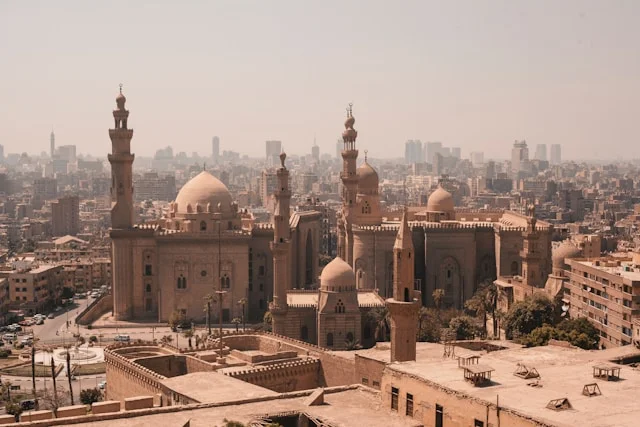Egypt, the cradle of civilization, is a land of awe-inspiring monuments and rich history that spans over millennia. The ancient wonders of Egypt, from the towering pyramids to the majestic temples, offer a fascinating glimpse into the past. This guide will take you on a journey through the most significant historical sites, providing comprehensive insights into their architectural marvels, cultural significance, and the intriguing stories that lie within.
1. The Great Pyramids of Giza
The Pyramid of Khufu (The Great Pyramid)
The Great Pyramid of Giza, built for Pharaoh Khufu, is one of the most iconic structures in the world.
- Construction and Dimensions: Standing at an original height of 146.6 meters, it was the tallest man-made structure for over 3,800 years. It consists of approximately 2.3 million limestone blocks, each weighing an average of 2.5 tons.
- Interior Chambers: Explore the King’s Chamber, the Queen’s Chamber, and the mysterious Grand Gallery, which showcase the advanced engineering skills of the ancient Egyptians.
The Pyramid of Khafre and the Great Sphinx
Pharaoh Khafre’s pyramid, slightly smaller than Khufu’s, is accompanied by the enigmatic Great Sphinx.
- Architectural Features: The pyramid retains some of its original casing stones at the top, providing a glimpse of its former glory. The complex also includes mortuary temples and the Valley Temple.
- The Sphinx: Carved from a single limestone block, the Sphinx features a lion’s body with a human head, believed to represent Pharaoh Khafre. Its purpose remains a subject of debate among historians.
The Pyramid of Menkaure
The smallest of the three pyramids at Giza, Menkaure’s Pyramid is notable for its complex of subsidiary pyramids.
- Complex Layout: The pyramid complex includes a mortuary temple, a valley temple, and three smaller queen’s pyramids. Excavations have revealed intricate statues and artifacts within the site.
2. The Temples of Luxor and Karnak
The Luxor Temple
Located on the east bank of the Nile, the Luxor Temple is a testament to the grandeur of ancient Egyptian architecture.
- Historical Significance: Built primarily by Amenhotep III and Ramses II, the temple was dedicated to the rejuvenation of kingship. It played a central role in the annual Opet Festival.
- Key Features: The temple complex includes the Avenue of Sphinxes, the colossal statues of Ramses II, and the grand colonnade that leads to the inner sanctuaries.
The Karnak Temple Complex
The Karnak Temple Complex is the largest religious building ever constructed, spanning over 200 acres.
- Hypostyle Hall: One of the most impressive features is the Great Hypostyle Hall, with its 134 massive columns arranged in 16 rows, creating a forest of stone.
- Sacred Lake and Obelisks: The complex also includes a sacred lake, various obelisks, and the Temple of Amun, dedicated to the chief deity of the New Kingdom.
3. The Valley of the Kings
Tombs of the Pharaohs
The Valley of the Kings, located on the west bank of the Nile near Luxor, is the final resting place of many New Kingdom pharaohs.
- Notable Tombs: Highlights include the tomb of Tutankhamun, discovered by Howard Carter in 1922, and the tomb of Ramses VI, known for its vivid wall paintings.
- Architectural Marvels: The tombs are carved deep into the cliffs and adorned with intricate hieroglyphs and elaborate burial chambers filled with treasures intended for the afterlife.

The Mortuary Temple of Hatshepsut
One of the most striking monuments in the Valley of the Kings is the Mortuary Temple of Hatshepsut.
- Design and Architecture: This terraced temple, built into the cliffs of Deir el-Bahari, features a series of colonnaded terraces connected by ramps, showcasing a unique blend of natural and architectural beauty.
- Historical Context: Hatshepsut was one of the few female pharaohs, and her temple serves as a testament to her reign and her contributions to Egyptian history.
4. Abu Simbel: The Temples of Ramses II
The Great Temple of Ramses II
The Great Temple of Abu Simbel is a masterpiece of ancient Egyptian engineering and artistry.
- Colossal Statues: The temple facade features four colossal statues of Ramses II, each standing 20 meters tall, guarding the entrance.
- Astronomical Alignment: The temple is aligned so that twice a year, the sun’s rays illuminate the inner sanctuary, highlighting statues of Ramses and the gods Amun and Ra-Horakhty.
The Small Temple of Nefertari
Dedicated to Ramses II’s favorite queen, Nefertari, the Small Temple is equally impressive.
- Decorative Reliefs: The temple walls are adorned with elaborate reliefs depicting the queen and the gods, showcasing the artistic excellence of the period.
- Historical Significance: The dedication of a temple to a queen was a rare honor, reflecting Nefertari’s importance in Ramses II’s life.
5. The Richness of Egyptian Museums
The Egyptian Museum in Cairo
The Egyptian Museum houses the world’s most extensive collection of ancient Egyptian artifacts.
- Tutankhamun’s Treasures: The museum is famous for the treasures of Tutankhamun, including his golden death mask, jewelry, and chariots.
- Ancient Statues and Relics: Other highlights include the statues of Khafre and Menkaure, the Narmer Palette, and a vast collection of mummies and sarcophagi.
The Grand Egyptian Museum
Set to be the largest archaeological museum in the world, the Grand Egyptian Museum will showcase an unparalleled collection of Egypt’s ancient treasures.
- Comprehensive Exhibits: The museum will feature thousands of artifacts, many of which have never been displayed before, offering a comprehensive look into Egypt’s rich history.
- State-of-the-Art Facilities: With cutting-edge conservation and display techniques, the museum aims to provide an immersive and educational experience for visitors.


